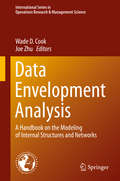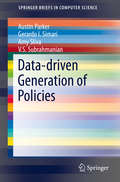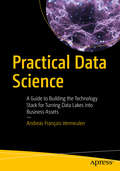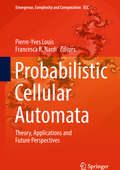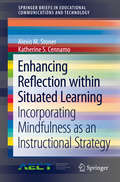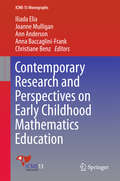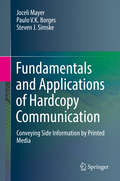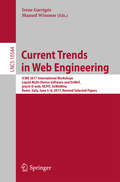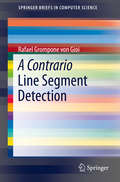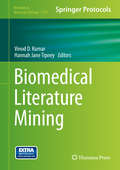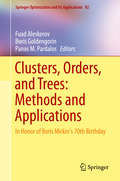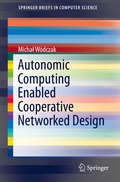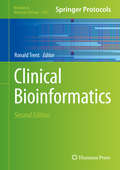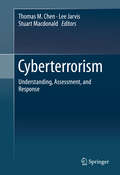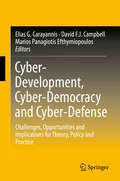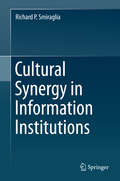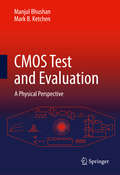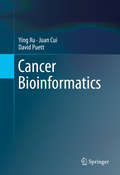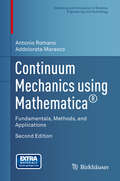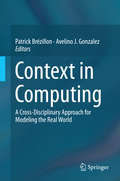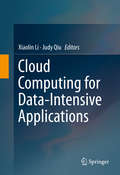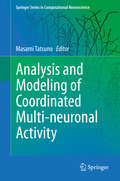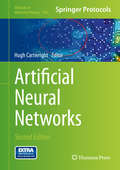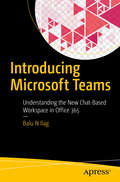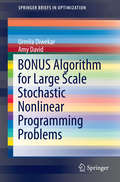- Table View
- List View
Data Envelopment Analysis: A Handbook of Modeling Internal Structure and Network (International Series in Operations Research & Management Science #208)
by Joe Zhu Wade D. CookThis handbook serves as a complement to the Handbook on Data Envelopment Analysis (eds, W. W. Cooper, L. M. Seiford and J, Zhu, 2011, Springer) in an effort to extend the frontier of DEA research. It provides a comprehensive source for the state-of-the art DEA modeling on internal structures and network DEA. Chapter 1 provides a survey on two-stage network performance decomposition and modeling techniques. Chapter 2 discusses the pitfalls in network DEA modeling. Chapter 3 discusses efficiency decompositions in network DEA under three types of structures, namely series, parallel and dynamic. Chapter 4 studies the determination of the network DEA frontier. In chapter 5 additive efficiency decomposition in network DEA is discussed. An approach in scale efficiency measurement in two-stage networks is presented in chapter 6. Chapter 7 further discusses the scale efficiency decomposition in two stage networks. Chapter 8 offers a bargaining game approach to modeling two-stage networks. Chapter 9 studies shared resources and efficiency decomposition in two-stage networks. Chapter 10 introduces an approach to computing the technical efficiency scores for a dynamic production network and its sub-processes. Chapter 11 presents a slacks-based network DEA. Chapter 12 discusses a DEA modeling technique for a two-stage network process where the inputs of the second stage include both the outputs from the first stage and additional inputs to the second stage. Chapter 13 presents an efficiency measurement methodology for multi-stage production systems. Chapter 14 discusses network DEA models, both static and dynamic. The discussion also explores various useful objective functions that can be applied to the models to find the optimal allocation of resources for processes within the black box, that are normally invisible to DEA. Chapter 15 provides a comprehensive review of various type network DEA modeling techniques. Chapter 16 presents shared resources models for deriving aggregate measures of bank-branch performance, with accompanying component measures that make up that aggregate value. Chapter 17 examines a set of manufacturing plants operating under a single umbrella, with the objective being to use the component or function measures to decide what might be considered as each plant's core business. Chapter 18 considers problem settings where there may be clusters or groups of DMUs that form a hierarchy. The specific case of a set off electric power plants is examined in this context. Chapter 19 models bad outputs in two-stage network DEA. Chapter 20 presents an application of network DEA to performance measurement of Major League Baseball (MLB) teams. Chapter 21 presents an application of a two-stage network DEA model for examining the performance of 30 U. S. airline companies. Chapter 22 then presents two distinct network efficiency models that are applied to engineering systems.
Data-driven Generation of Policies (SpringerBriefs in Computer Science)
by Amy Sliva V. S. Subrahmanian Austin Parker Gerardo I. SimariThis Springer Brief presents a basic algorithm that provides a correct solution to finding an optimal state change attempt, as well as an enhanced algorithm that is built on top of the well-known trie data structure. It explores correctness and algorithmic complexity results for both algorithms and experiments comparing their performance on both real-world and synthetic data. Topics addressed include optimal state change attempts, state change effectiveness, different kind of effect estimators, planning under uncertainty and experimental evaluation. These topics will help researchers analyze tabular data, even if the data contains states (of the world) and events (taken by an agent) whose effects are not well understood. Event DBs are omnipresent in the social sciences and may include diverse scenarios from political events and the state of a country to education-related actions and their effects on a school system. With a wide range of applications in computer science and the social sciences, the information in this Springer Brief is valuable for professionals and researchers dealing with tabular data, artificial intelligence and data mining. The applications are also useful for advanced-level students of computer science.
Practical Data Science
by Andreas François VermeulenLearn how to build a data science technology stack and perform good data science with repeatable methods. You will learn how to turn data lakes into business assets.The data science technology stack demonstrated in Practical Data Science is built from components in general use in the industry. Data scientist Andreas Vermeulen demonstrates in detail how to build and provision a technology stack to yield repeatable results. He shows you how to apply practical methods to extract actionable business knowledge from data lakes consisting of data from a polyglot of data types and dimensions.What You'll LearnBecome fluent in the essential concepts and terminology of data science and data engineering Build and use a technology stack that meets industry criteriaMaster the methods for retrieving actionable business knowledgeCoordinate the handling of polyglot data types in a data lake for repeatable resultsWho This Book Is ForData scientists and data engineers who are required to convert data from a data lake into actionable knowledge for their business, and students who aspire to be data scientists and data engineers
Probabilistic Cellular Automata: Theory, Applications And Future Perspectives (Emergence, Complexity And Computation Ser. #27)
by Pierre-Yves Louis Francesca R. NardiThis book explores Probabilistic Cellular Automata (PCA) from the perspectives of statistical mechanics, probability theory, computational biology and computer science. PCA are extensions of the well-known Cellular Automata models of complex systems, characterized by random updating rules. Thanks to their probabilistic component, PCA offer flexible computing tools for complex numerical constructions, and realistic simulation tools for phenomena driven by interactions among a large number of neighboring structures. PCA are currently being used in various fields, ranging from pure probability to the social sciences and including a wealth of scientific and technological applications. This situation has produced a highly diversified pool of theoreticians, developers and practitioners whose interaction is highly desirable but can be hampered by differences in jargon and focus. This book – just as the workshop on which it is based – is an attempt to overcome these difference and foster interest among newcomers and interaction between practitioners from different fields. It is not intended as a treatise, but rather as a gentle introduction to the role and relevance of PCA technology, illustrated with a number of applications in probability, statistical mechanics, computer science, the natural sciences and dynamical systems. As such, it will be of interest to students and non-specialists looking to enter the field and to explore its challenges and open issues.
Enhancing Reflection within Situated Learning: Incorporating Mindfulness As An Instructional Strategy (Springerbriefs In Educational Communications And Technology Ser.)
by Alexis M. Stoner Katherine S. CennamoThis innovative brief provides guidance on promoting reflection in situated learning by incorporating mindfulness strategies, tapping into a surge of research interest in exploring mindfulness as an instructional strategy associated with positive learning outcomes. It illustrates the benefits of continuous reflection within situated learning and how mindfulness can be incorporated before, during, and after the learning experience to enhance the reflective experience. Critically, the authors present a new conceptual model that synthesizes theories and methods from three different areas of study—mindfulness, situated learning, and reflection— to provide a new perspective and instructional approach that has great potential to positively impact outcomes in situated learning.Among the other topics covered:• Strategies for reflection in situated learning.• Strategies for reflection-in-action in situated learning.• Mindfulness strategies for situated learning.• A conceptual model incorporating mindfulness to enhance reflection.Enhancing Reflection within Situated Learning is an exciting and pioneering resource that offers practical guidance to educators and instructional designers interested in incorporating methods and approaches for integrating mindfulness and reflection across instructional environments.
Contemporary Research and Perspectives on Early Childhood Mathematics Education (ICME-13 Monographs)
by Iliada Elia Joanne Mulligan Ann Anderson Anna Baccaglini-Frank Christiane BenzThis book brings together a collection of research-based papers on current issues in early childhood mathematics education that were presented in the Topic Study Group 1 (TSG 1) at the 13th International Congress on Mathematical Education (ICME-13), held at the University of Hamburg in 2016. It will help readers understand a range of key issues that early childhood mathematics educators encounter today. Research on early childhood mathematics education has grown in recent years, due in part to the well-documented, positive relation between children’s early mathematical knowledge and their later mathematics learning, and to the considerable emphasis many countries are now placing on preschool education. The book addresses a number of central questions, including: What is mathematical structural development and how can we promote it in early childhood? How can multimodality and embodiment contribute to early mathematics learning and to acquiring a better understanding of young children’s mathematical development? How can children’s informal mathematics-related experiences affect instruction and children’s learning in different mathematics content areas? What is the role of tools, including technology and picture books, in supporting early mathematics learning? What are the challenges in early childhood mathematics education for teachers’ education and professional development?
Fundamentals and Applications of Hardcopy Communication: Conveying Side Information By Printed Media
by Joceli Mayer Steven J. Simske Paulo V.K. BorgesThis book presents covert, semi-covert and overt techniques for communication over printed media by modifying images, texts or barcodes within the document. Basic and advanced techniques are discussed aimed to modulate information into images, texts and barcodes.Conveying information over printed media can be useful for content authentication, author copyright, information and piracy product deterrent, side information for marketing, among other applications. Practical issues are discussed and experiments are provided to evaluate competitive approaches for hard-copy communication.This book is a useful resource for researchers, practitioners and graduate students in the field of hard-copy communication by providing the fundamentals, basic and advanced techniques as examples of approaches to address the hard-copy media distortions and particularities.
Current Trends in Web Engineering: Icwe 2012 International Workshops Mdwe, Composableweb, Were, Qwe, And Doctoral Consortium, Berlin, Germany, July 2012, Revised Selected Papers (Lecture Notes In Computer Science / Information Systems And Applications, Incl. Internet/web, And Hci Ser. #7703)
by Irene Garrigós Manuel WimmerThis book constitutes the refereed thoroughly refereed post-workshop proceedings of the 17th International Conference on Web Engineering, ICWE 2017, held in Rome, Italy, in June 2017.The 24 revised full papers were selected from 34 submissions. The workshops complement the main conference, and explore new trends on core topics of Web engineering. The workshop committee accepted five workshops of which the following four contributed papers to this volume: - 2nd International Workshop on Liquid Multi-Device Software and 1st International Workshop on Engineering the Web of Things - International Workshop on The Practice Of The Open Web (practi-O-web 2017) - 3rd International Workshop on Natural Language Processing for Informal Text (NLPIT 2017)- 3rd International Workshop on Mining the Social Web (SoWeMine 2017).
A Contrario Line Segment Detection (SpringerBriefs in Computer Science)
by Rafael Grompone von GioiThe reliable detection of low-level image structures is an old and still challenging problem in computer vision. This book leads a detailed tour through the LSD algorithm, a line segment detector designed to be fully automatic. Based on the a contrario framework, the algorithm works efficiently without the need of any parameter tuning. The design criteria are thoroughly explained and the algorithm's good and bad results are illustrated on real and synthetic images. The issues involved, as well as the strategies used, are common to many geometrical structure detection problems and some possible extensions are discussed.
Biomedical Literature Mining (Methods in Molecular Biology #1159)
by Vinod D. Kumar Hannah Jane TipneyBiomedical Literature Mining, discusses the multiple facets of modern biomedical literature mining and its many applications in genomics and systems biology. The volume is divided into three sections focusing on information retrieval, integrated text-mining approaches and domain-specific mining methods. Written in the highly successful Methods in Molecular Biology series format, chapters include introductions to their respective topics, lists of the necessary materials and reagents, step-by-step, readily reproducible laboratory protocols and key tips on troubleshooting and avoiding known pitfalls. Authoritative and practical, Biomedical Literature Mining is designed as a useful bioinformatics resource in biomedical literature text mining for both those long experienced in or entirely new to, the field.
Clusters, Orders, and Trees: In Honor of Boris Mirkin's 70th Birthday (Springer Optimization and Its Applications #92)
by Panos M. Pardalos Boris Goldengorin Fuad AleskerovThe volume is dedicated to Boris Mirkin on the occasion of his 70th birthday. In addition to his startling PhD results in abstract automata theory, Mirkin's ground breaking contributions in various fields of decision making and data analysis have marked the fourth quarter of the 20th century and beyond Mirkin has done pioneering work in group choice, clustering, data mining and knowledge discovery aimed at finding and describing non-trivial or hidden structures--first of all, clusters, orderings and hierarchies--in multivariate and/or network data. This volume contains a collection of papers reflecting recent developments rooted in Mirkin's fundamental contribution to the state-of-the-art in group choice, ordering, clustering, data mining and knowledge discovery. Researchers, students and software engineers will benefit from new knowledge discovery techniques and application directions.
Autonomic Computing Enabled Cooperative Networked Design (SpringerBriefs in Computer Science)
by Michał WódczakThis book introduces the concept of autonomic computing driven cooperative networked system design from an architectural perspective. As such it leverages and capitalises on the relevant advancements in both the realms of autonomic computing and networking by welding them closely together. In particular, a multi-faceted Autonomic Cooperative System Architectural Model is defined which incorporates the notion of Autonomic Cooperative Behaviour being orchestrated by the Autonomic Cooperative Networking Protocol of a cross-layer nature. The overall proposed solution not only advocates for the inclusion of certain Decision Making Entities, but it also provides all the necessary implementation guidelines along with the pertinent standardisation orientated insight.
Clinical Bioinformatics (Methods in Molecular Biology #1168)
by Ronald TrentIn Clinical Bioinformatics, Second Edition, leading experts in the field provide a series of articles focusing on software applications used to translate information into outcomes of clinical relevance. Recent developments in omics, such as increasingly sophisticated analytic platforms allowing changes in diagnostic strategies from the traditional focus on single or small number of analytes to what might be possible when large numbers or all analytes are measured, are now impacting patient care. Covering such topics as gene discovery, gene function (microarrays), DNA sequencing, online approaches and resources, and informatics in clinical practice, this volume concisely yet thoroughly explores this cutting-edge subject Written in the successful Methods in Molecular Biology series format, chapters include introductions to their respective topics, lists of the necessary materials and reagents, step-by-step, readily reproducible protocols, and notes on troubleshooting and avoiding known pitfalls. Authoritative and easily accessible, Clinical Bioinformatics, Second Edition serves as an ideal guide for scientists and health professionals working in genetics and genomics.
Cyberterrorism: Understanding, Assessment, and Response
by Thomas M. Chen Lee Jarvis Stuart MacdonaldThis is the first book to present a multidisciplinary approach to cyberterrorism It traces the threat posed by cyberterrorism today, with chapters discussing possible technological vulnerabilities, potential motivations to engage in cyberterrorism, and the challenges of distinguishing this from other cyber threats. The book also addresses the range of potential responses to this threat by exploring policy and legislative frameworks as well as a diversity of techniques for deterring or countering terrorism in cyber environments. The case studies throughout the book are global in scope and include the United States, United Kingdom, Australia, New Zealand and Canada. With contributions from distinguished experts with backgrounds including international relations, law, engineering, computer science, public policy and politics, Cyberterrorism: Understanding, Assessment and Response offers a cutting edge analysis of contemporary debate on, and issues surrounding, cyberterrorism. This global scope and diversity of perspectives ensure it is of great interest to academics, students, practitioners, policymakers and other stakeholders with an interest in cyber security.
Cyber-Development, Cyber-Democracy and Cyber-Defense: Challenges, Opportunities and Implications for Theory, Policy and Practice
by Elias G. Carayannis David F. J. Campbell Marios Panagiotis EfthymiopoulosIn this volume, contributors from academia, industry, and policy explore the inter-connections among economic development, socio-political democracy and defense and security in the context of a profound transformation, spurred by globalization and supported by the rapid development of information and communication technologies (ICT). This powerful combination of forces is changing the way we live and redefining the way companies conduct business and national governments pursue strategies of innovation, economic growth and diplomacy. Integrating theoretical frameworks, empirical research and case studies, the editors and contributors have organized the chapters into three major sections, focusing on cyber-development, cyber-democracy and cyber-defense. The authors define cyber-development as a set of tools, methodologies and practices that leverage ICT to catalyze and accelerate social, political and economic development, with an emphasis on making the transition to knowledge-based economies. One underlying understanding here is that knowledge, knowledge creation, knowledge production and knowledge application (innovation) behave as crucial drivers for enhancing democracy, society, and the economy. By promoting dissemination and sharing of knowledge, cyber-democracy allows a knowledge conversion of the local into the global (gloCal) and vice versa, resulting in a gloCal platform for communication and knowledge interaction and knowledge enhancement Meanwhile, technology-enabled interconnectivity increases the need to adopt new methods and actions for protection against existing threats and possible challenges to emerge in the future The final section contemplates themes of cyber-defense and security, as well as emerging theories and values, legal aspects and trans-continental links (NATO, international organizations and bilateral relations between states) Collectively, the authors present a unique collection of insights and perspectives on the challenges and opportunities inspired by connectivity.
Cultural Synergy in Information Institutions
by Richard P. SmiragliaCultural forces govern a synergistic relationship among information institutions that shapes their roles collectively and individually. Cultural synergy is the combination of perception- and behavior-shaping knowledge within, between, and among groups. Our hyperlinked era makes information-sharing among institutions critically important for scholarship as well as for the advancement of humankind. Information institutions are those that have, or share in, the mission to preserve, conserve, and disseminate information objects and their informative content. A central idea is the notion of social epistemology that information institutions arise culturally from social forces of the cultures they inhabit, and that their purpose is to disseminate that culture. All information institutions are alike in critical ways. Intersecting lines of cultural mission are trajectories for synergy for allowing us to perceive the universe of information institutions as interconnected and evolving and moving forward in distinct ways for the improvement of the condition of humankind through the building up of its knowledge base and of its information-sharing processes. This book is an exploration of the cultural synergy that can be realized by seeing commonalities among information institutions (sometimes also called cultural heritage institutions): museums, libraries, and archives. The hyperlinked era of the Semantic Web makes information sharing among institutions critically important for scholarship as well as the advancement of mankind. The book addresses the origins of cultural information institutions, the history of the professions that run them, and the social imperative of information organization as a catalyst for semantic synergy.
CMOS Test and Evaluation: A Physical Perspective
by Mark B. Ketchen Manjul BhushanCMOS Test and Evaluation: A Physical Perspective is a single source for an integrated view of test and data analysis methodology for CMOS products, covering circuit sensitivities to MOSFET characteristics, impact of silicon technology process variability, applications of embedded test structures and sensors, product yield, and reliability over the lifetime of the product. This book also covers statistical data analysis and visualization techniques, test equipment and CMOS product specifications, and examines product behavior over its full voltage, temperature and frequency range.
Cancer Bioinformatics
by Ying Xu Juan Cui David PuettThis book provides a framework for computational researchers studying the basics of cancer through comparative analyses of omic data. It discusses how key cancer pathways can be analyzed and discovered to derive new insights into the disease and identifies diagnostic and prognostic markers for cancer. Chapters explain the basic cancer biology and how cancer develops, including the many potential survival routes. The examination of gene-expression patterns uncovers commonalities across multiple cancers and specific characteristics of individual cancer types. The authors also treat cancer as an evolving complex system, explore future case studies, and summarize the essential online data sources. Cancer Bioinformatics is designed for practitioners and researchers working in cancer research and bioinformatics. It is also suitable as a secondary textbook for advanced-level students studying computer science, biostatistics or biomedicine.
Continuum Mechanics using Mathematica®: Fundamentals, Methods, and Applications (Modeling and Simulation in Science, Engineering and Technology)
by Antonio Romano Addolorata MarascoThis textbook's methodological approach familiarizes readers with the mathematical tools required to correctly define and solve problems in continuum mechanics. Covering essential principles and fundamental applications, this second edition of Continuum Mechanics using Mathematica® provides a solid basis for a deeper study of more challenging and specialized problems related to nonlinear elasticity, polar continua, mixtures, piezoelectricity, ferroelectricity, magneto-fluid mechanics and state changes (see A. Romano, A. Marasco, Continuum Mechanics: Advanced Topics and Research Trends, Springer (Birkhäuser), 2010, ISBN 978-0-8176-4869-5). Key topics and features: * Concise presentation strikes a balance between fundamentals and applications * Requisite mathematical background carefully collected in two introductory chapters and one appendix * Recent developments highlighted through coverage of more significant applications to areas such as wave propagation, fluid mechanics, porous media, linear elasticity. This second edition expands the key topics and features to include: * Two new applications of fluid dynamics: meteorology and navigation * New exercises at the end of the existing chapters * The packages are rewritten for Mathematica 9 Continuum Mechanics using Mathematica®: Fundamentals, Applications and Scientific Computing is aimed at advanced undergraduates, graduate students and researchers in applied mathematics, mathematical physics and engineering. It may serve as a course textbook or self-study reference for anyone seeking a solid foundation in continuum mechanics.
Context in Computing: A Cross-Disciplinary Approach for Modeling the Real World
by Patrick Brézillon Avelino J. GonzalezThis volume explores how context has been and can be used in computing to model human behaviors, actions and communications as well as to manage data and knowledge. It addresses context management and exploitation of context for sharing experience across domains. The book serves as a user-centric guide for readers wishing to develop context-based applications, as well as an intellectual reference on the concept of context. It provides a broad yet deep treatment of context in computing and related areas that depend heavily on computing. The coverage is broad because of its cross-disciplinary nature but treats topics at a sufficient depth to permit a reader to implement context in his/her computational endeavors. The volume addresses how context can be integrated in software and systems and how it can be used in a computing environment. Furthermore, the use of context to represent the human dimension, individually as well as collectively is explained. Contributions also include descriptions of how context has been represented in formal as well as non-formal, structured approaches. The last section describes several human behavior representation paradigms based on the concept of context as its central representational element. The depth and breadth of this content is certain to provide useful as well as intellectually enriching information to readers of diverse backgrounds who have an interest in or are intrigued by using context to assist in their representation of the real world.
Cloud Computing for Data-Intensive Applications
by Xiaolin Li Judy QiuThis book presents a range of cloud computing platforms for data-intensive scientific applications. It covers systems that deliver infrastructure as a service, including: HPC as a service; virtual networks as a service; scalable and reliable storage; algorithms that manage vast cloud resources and applications runtime; and programming models that enable pragmatic programming and implementation toolkits for eScience applications. Many scientific applications in clouds are also introduced, such as bioinformatics, biology, weather forecasting and social networks. Most chapters include case studies. Cloud Computing for Data-Intensive Applications targets advanced-level students and researchers studying computer science and electrical engineering. Professionals working in cloud computing, networks, databases and more will also find this book useful as a reference.
Analysis and Modeling of Coordinated Multi-neuronal Activity (Springer Series in Computational Neuroscience #12)
by Masami TatsunoSince information in the brain is processed by the exchange of spikes among neurons, a study of such group dynamics is extremely important in understanding hippocampus dependent memory. These spike patterns and local field potentials (LFPs) have been analyzed by various statistical methods. These studies have led to important findings of memory information processing. For example, memory-trace replay, a reactivation of behaviorally induced neural patterns during subsequent sleep, has been suggested to play an important role in memory consolidation. It has also been suggested that a ripple/sharp wave event (one of the characteristics of LFPs in the hippocampus) and spiking activity in the cortex have a specific relationship that may facilitate the consolidation of hippocampal dependent memory from the hippocampus to the cortex. The book will provide a state-of-the-art finding of memory information processing through the analysis of multi-neuronal data. The first half of the book is devoted to this analysis aspect. Understanding memory information representation and its consolidation, however, cannot be achieved only by analyzing the data. It is extremely important to construct a computational model to seek an underlying mathematical principle. In other words, an entire picture of hippocampus dependent memory system would be elucidated through close collaboration among experiments, data analysis, and computational modeling. Not only does computational modeling benefit the data analysis of multi-electrode recordings, but it also provides useful insight for future experiments and analyses. The second half of the book will be devoted to the computational modeling of hippocampus-dependent memory.
Artificial Neural Networks (Methods in Molecular Biology #1260)
by Hugh CartwrightThis volume presents examples of how ANNs are applied in biological sciences and related areas. Chapters focus on the analysis of intracellular sorting information, prediction of the behavior of bacterial communities, biometric authentication, studies of Tuberculosis, gene signatures in breast cancer classification, use of mass spectrometry in metabolite identification, visual navigation, and computer diagnosis. Written in the highly successful Methods in Molecular Biology series format, chapters include introductions to their respective topics, application details for both the expert and non-expert reader, and tips on troubleshooting and avoiding known pitfalls. Authoritative and practical, Artificial Neural Networks: Second Edition aids scientists in continuing to study Artificial Neural Networks (ANNs).
Introducing Microsoft Teams: Understanding the New Chat-Based Workspace in Office 365
by Balu N IlagGain industry best practices from planning to implementing Microsoft Teams and learn how to enable, configure, and integrate user provisioning, management, and monitoring. This book also covers troubleshooting Teams with step-by-step instructions and examples. Introducing Microsoft Teams gives you the comprehensive coverage you need to creatively utilize Microsoft Teams services.The author starts by giving an introduction to Microsoft Teams and its architecture followed by optimizing the Teams experience where he describes how organizations can prepare for Teams and enhance existing services. He further shows you how to manage and control the Microsoft Teams experience along with its capabilities and enhancements. You’ll learn how to migrate from Skype for Business to Microsoft Teams with a step-by-step tutorial. Finally, you’ll get to grips with Teams troubleshooting and best practices.This book has detailed coverage that helps you exploit every capability Microsoft Teams has to offer. It provides the answers you need and the insight that will make your journey from Skype for Business to Teams easier. What You Will Learn Enable guest access in Teams Provision and manage users in Teams Administrate Teams and channelsOptimize the Teams experienceEnable and configure Microsoft TeamsPrepare your network for Microsoft Teams and Office 365 services Migrate from Skype for Business to Microsoft TeamsWho This Book Is ForUnified communication administrators and IT support engineers who are currently supporting an existing unified communication platform such as Skype for Business (Lync). It would also help support engineers, new administrators, and consultant to start their journey with Teams.
BONUS Algorithm for Large Scale Stochastic Nonlinear Programming Problems (SpringerBriefs in Optimization)
by Urmila Diwekar Amy DavidThis book presents the details of the BONUS algorithm and its real world applications in areas like sensor placement in large scale drinking water networks, sensor placement in advanced power systems, water management in power systems, and capacity expansion of energy systems. A generalized method for stochastic nonlinear programming based on a sampling based approach for uncertainty analysis and statistical reweighting to obtain probability information is demonstrated in this book. Stochastic optimization problems are difficult to solve since they involve dealing with optimization and uncertainty loops. There are two fundamental approaches used to solve such problems. The first being the decomposition techniques and the second method identifies problem specific structures and transforms the problem into a deterministic nonlinear programming problem. These techniques have significant limitations on either the objective function type or the underlying distributions for the uncertain variables. Moreover, these methods assume that there are a small number of scenarios to be evaluated for calculation of the probabilistic objective function and constraints. This book begins to tackle these issues by describing a generalized method for stochastic nonlinear programming problems. This title is best suited for practitioners, researchers and students in engineering, operations research, and management science who desire a complete understanding of the BONUS algorithm and its applications to the real world.
